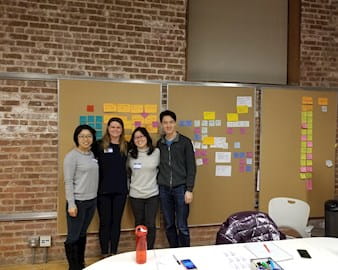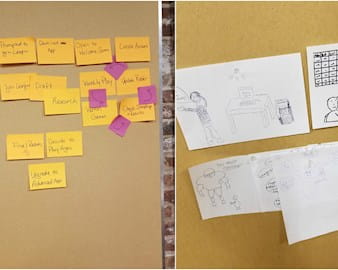Design Thinking in Five Steps
Design Thinking is having a moment right now.
A concept that was once the domain of technology titans and CPG giants seems to have seeped into the DNA of companies of all industries and sizes in recent years. Students and professionals skilled in Design Thinking bring new insights to organizations and add value to innovation projects.
- By
- April 04, 2018
- Innovation

But how does one learn the Design Thinking methodology?
Look no further than the New Products and Services Lab. This 10-week course partners student teams with companies to solve a real-life business innovation problem. During weekly class sessions students study the Design Thinking framework and, outside of class, apply the concepts to developing and testing new products and services that address both customer and company needs.
Phase 1: Identifying Customer Needs
My team of five was partnered with Verizon and were tasked with finding new opportunities within the fantasy sports market. After conducting thorough background research on the market and discussing our findings with company stakeholders, we were ready to conduct qualitative interviews with consumers. Through an incredible tool called UserTesting.com we were able to video interview consumers from our target demographics to learn about their media consumption patterns and behaviors. By analyzing these interviews within our team, we identified and isolated unique core customer needs to address with our concept ideas.

Phase 2: Ideation
Once we knew what our target customers wanted and needed from a new product, we moved to the ideation phase of the Design Thinking process. Over several weeks, we spent hours brainstorming new ideas, and even went through a high-energy guided brainstorming session where we were pushed to come up with our most creative, wacky, and ultimately innovative concepts. We then applied an objective framework to rank and analyze our ideas and presented the ‘top ten’ contenders to Verizon.
Phase 3: Concept Development
After validating the client’s preferred concepts, it was time to bring our top three ideas to life! For one evening we relocated our classroom to the Salesforce Ignite studio where we rolled up our sleeves and created product prototypes to use in both qualitative and quantitative concept tests. Through a series of guided exercises and short learning bursts, we created a story board depicting the value and benefits of our top concepts.
Phase 4: Concept Testing
Armed with concept statements and visuals of each of our prototypes (all three mobile applications), we moved forward with quantitative testing. As any good Boothie knows, decision making is all about the data! With guidance from Professor Middlebrooks and our faculty coach, the team designed a Qualtrics survey to test how well each concept performed within our target demographics. After analyzing the results from every angle, we finally identified the winning concept!
Phase 5: Final Recommendations
Now in the final weeks of class we set about forecasting sales targets, evaluating potential competitor response, and outlining a go-to-market strategy. The course culminated in a final meeting with our Verizon stakeholders where we walked through each phase of the project and presented the winning concept.
In just ten short weeks we’d transformed a customer problem statement into a brand-new fully formed product concept tailored and tested to solve that problem. The entire experience exceeded my expectations. Not only have I learned Design Thinking methodology, I’ve actually executed an entire DT cycle. I’m especially thankful for my incredible group of first-year Full-Time Program students (Zidi Chen, Erin Wang, Patrick Yu, and Laurie Michaelson). Overall, the New Products and Services Lab is one of the most fun and immediately applicable classes I’ve taken at Booth and I am certain it will help me succeed in future endeavors.